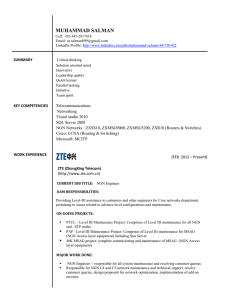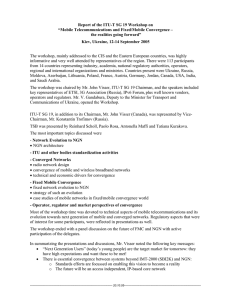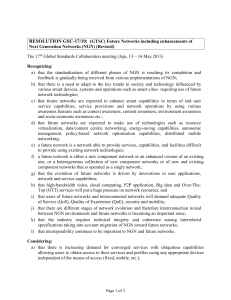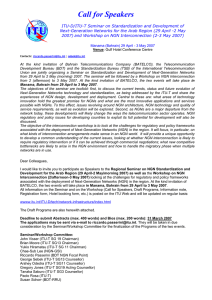ITU-T/ICG-SAT Workshop: “SATELLITES IN NGN?” Montreal 13 July 2007 Report
advertisement
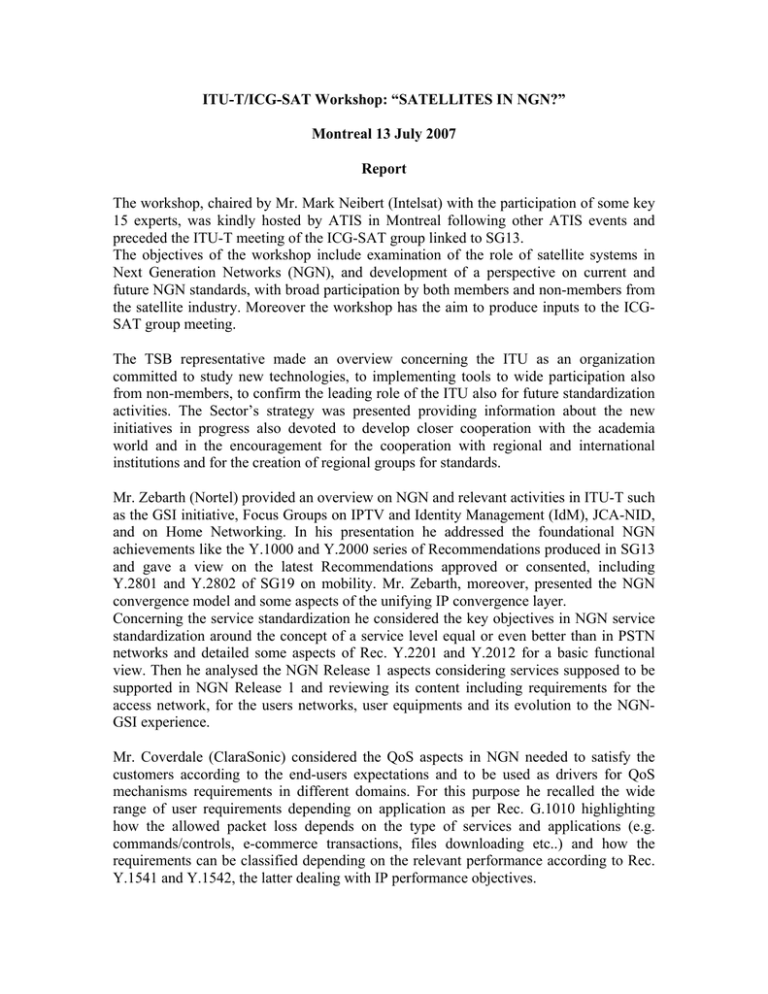
ITU-T/ICG-SAT Workshop: “SATELLITES IN NGN?” Montreal 13 July 2007 Report The workshop, chaired by Mr. Mark Neibert (Intelsat) with the participation of some key 15 experts, was kindly hosted by ATIS in Montreal following other ATIS events and preceded the ITU-T meeting of the ICG-SAT group linked to SG13. The objectives of the workshop include examination of the role of satellite systems in Next Generation Networks (NGN), and development of a perspective on current and future NGN standards, with broad participation by both members and non-members from the satellite industry. Moreover the workshop has the aim to produce inputs to the ICGSAT group meeting. The TSB representative made an overview concerning the ITU as an organization committed to study new technologies, to implementing tools to wide participation also from non-members, to confirm the leading role of the ITU also for future standardization activities. The Sector’s strategy was presented providing information about the new initiatives in progress also devoted to develop closer cooperation with the academia world and in the encouragement for the cooperation with regional and international institutions and for the creation of regional groups for standards. Mr. Zebarth (Nortel) provided an overview on NGN and relevant activities in ITU-T such as the GSI initiative, Focus Groups on IPTV and Identity Management (IdM), JCA-NID, and on Home Networking. In his presentation he addressed the foundational NGN achievements like the Y.1000 and Y.2000 series of Recommendations produced in SG13 and gave a view on the latest Recommendations approved or consented, including Y.2801 and Y.2802 of SG19 on mobility. Mr. Zebarth, moreover, presented the NGN convergence model and some aspects of the unifying IP convergence layer. Concerning the service standardization he considered the key objectives in NGN service standardization around the concept of a service level equal or even better than in PSTN networks and detailed some aspects of Rec. Y.2201 and Y.2012 for a basic functional view. Then he analysed the NGN Release 1 aspects considering services supposed to be supported in NGN Release 1 and reviewing its content including requirements for the access network, for the users networks, user equipments and its evolution to the NGNGSI experience. Mr. Coverdale (ClaraSonic) considered the QoS aspects in NGN needed to satisfy the customers according to the end-users expectations and to be used as drivers for QoS mechanisms requirements in different domains. For this purpose he recalled the wide range of user requirements depending on application as per Rec. G.1010 highlighting how the allowed packet loss depends on the type of services and applications (e.g. commands/controls, e-commerce transactions, files downloading etc..) and how the requirements can be classified depending on the relevant performance according to Rec. Y.1541 and Y.1542, the latter dealing with IP performance objectives. Concerning the impact of satellites it was considered that delay as shown in table A.1/G.114 of SG12 with some basic approaches to ensure end-to-end QoS characteristics especially analyzing the voice delay aspects and the challenges to ensure a certain level of the end-to-end QoS and the inter-relationship among its various factors. In summary it was highlighted that QoS/QoE requirements for multimedia services in NGN cover a wide range of network performance. In particular, for satellite, the delay is one of the factors to be considered for standards requirements in multimedia services, algorithms for mapping and allocation of QoS values to the various network domains and architecture and protocols for QoS priority and traffic signaling. Mr. Weinrich (Globalstar) presented NGN over Satellite issue from ITU-R, especially WP4B, perspective, performance and resource requirements. He presented the various satellite services types: Fixed for fixed stations, internet and backbone; Mobile for small mobile end terminals and Broadcasting stations for satellite point-to-point/multipoint services. From the satellite network viewpoint the NGN characteristics mean: a) packet transmission, b) seamless connectivity and c) mobility and Mr. Weinrich analyzed how these functional characteristics can be achieved. Various S-series ITU-R Recommendations were recalled as relevant to performance and availability. Based on Rec S.1709, Mr. Weinrich made also a comparison concerning network topology, outbound traffic access method, inbound traffic data rate and protocols between ETSI and TIA standards among air interfaces. Various satellite resource requirements with bit rate and relevant earth station size were shown according to the portion of network under consideration, from the backbone to the “boundary” (islands satellite concept) and to the access, from hundreds of Mbit/s to Kbit/s. Future work of ITU-R WP4B will be devoted QoE : Quality of Experience intended as the contribution of satellite links in enhancing QoE of NGN connections and Availability. Such work should define the meaning availability in NGN and which parameters are to be determined for the performance. Moreover he concluded that NGN over Satellite issue with the consideration about the need to consider performance issues and resource requirements. Mr. Zebarth, in a second presentation, shown the status of the activities of the NGN Management Focus Group that is acting under the ITU-T SG4. A point was made concerning a liaison between the ITU-T and ITU-R SG4s and how ICG SAT group should address this issue. Mr. Sandesara (Telcordia) presented the ETS/TDR requirements and support by Satellite, introducing the concept of Emergency Telecommunication Services as national service to provide priority telecommunications (mainly authorization government issue for call/sessions) linked to Rec. E.107. He highlighted how while in PSTN networks the service can be easily implemented in the NGN environment it is more complex due to a different model. The speaker then shown the ATIS approach as an ETS service and considered the ATIS standards 1000010.2006 describing the support of ETS in an IP network. He informed about ongoing work to define service description for ETS in NGN e.g. voice, video, email instant messages and others. Main features are linked to international connectivity, authorization and authentication, security protection, priority and QoS level of ETS traffic even in high congestion situations. Mr. Sandesara recalled the ITU-T SGs involved in various aspects of ETS such as SG2 – for functional definitions, 13 - for requirements and 11 – for signaling. About TDR, telecommunication disaster relief, it is view as an international and national capability involving international, shared, temporary network facilities which issues are under study in a new ITU-T SG2 draft recommendation E.TDR. The TSB (ITU-T secretariat) allocated the E.164 code 888 to the UN-OCHA for terminals involved in TDR activities worldwide. After the tsunami event a PCP-TDR (partnership coordination panel) has been set up to discuss issues on how to develop mechanisms for effective disaster relief and for early warning actions. About the role of satellites, Mr. Sandesara shown that at moment there are no specifications of ETS functionalities for satellite services and that satellite support should involve service definition, architecture and interconnection specifications, authentication and authorization mechanisms and specifications for priority mechanisms. From the audience it was commented that ITU-R activities are more considering the use of satellites designed for mobile services as part of the whole ETS segment network to provide additional and temporarily replacement of telecom network in order to support ETS & TDR needs. Mr. Mitani (Mobile Satellite Ventures – MSV - Canada) presented the Next Generation Satellite System developed in MSV. He presented the main characteristics of a new project for a next generation satellites, for services delivery, able to cover wide areas in the Americas region. In particular it has been mentioned the high reliability and flexible design for dynamic bandwidth reallocation and coverage reconfiguration, especially in case of emergency situations, studied for 4G technology (L-band) mobile terminals. Network considerations shown how the next generation satellite is able to support next generation network requirements including FMC, and is compliant with regulatory requirements e.g. for emergency and privacy, security, lawful intercept, legacy, support of different access network technologies. The conclusions and Recommendations from the workshop were provided taking into account the workshop objectives. The main topics discussed were NGN activities and relationship between ITU-T and ITU-R: backbone, boundary and access portions, network management; satellites as part of the whole NGN environment; QoS / QoE requirements where delay is a factor to be considered, among others, and ETS and TDR issues, for example, links between terrestrial and satellites capabilities. The following conclusions were reached and recommendations agreed to be considered as an input to the ICG-SAT meeting of the day after: • Need to enhance ITU-T and ITU-R interaction for common aspects such as – QoS and QoE (ITU-T SG12) , – signaling (network signaling, resource access control, etc.), – emergency & disaster relief, – services/applications – media coding – echo control – network management – NGN protocols – NGN architecture should include satellite components • ….how?
